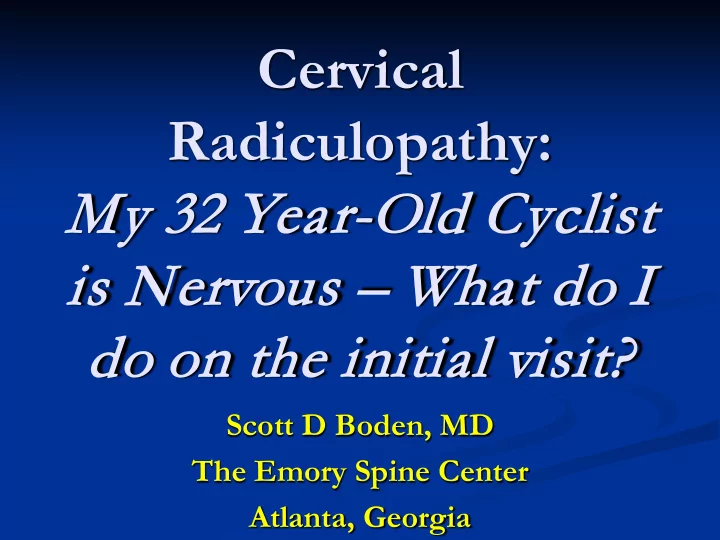

Cervical Radiculopathy: My 32 Y 32 Year-Old C d Cyclist is N s Ner ervous s – Wha hat d do I I do on t the in init itia ial vis isit it? Scott D Boden, MD The Emory Spine Center Atlanta, Georgia
History of Trauma? 2
History of Trauma? 3
Sometimes the source of Neck Pain is Obvious…
? Hyperextension 5
History: Red Flags Rarely spine pain is a harbinger of a serious medical illness. Red flags: Unexplained fevers, chills, night sweats (infection) Unexplained weight loss (tumor) History of cancer Night Pain – non-mechanical Cancer, Tumor, Fracture 6
Upper Limb Pain Radiculopathy Nerve root irritation or injury Symptoms and signs correspond to nerve roots Sensory disturbance Motor weakness Muscle stretch reflex may be decreased
Facet Referral Patterns
Diagram of Pain
Upper Limb Pain (Neuropathic) Myelopathy (sometimes painless) Cervical Radiculopathy Plexopathy (uncommon) Compression Parsonage Turner (Neuralgic amyotrophy) Stingers Entrapment neuropathies (ulnar, median etc) Peripheral neuropathy 10
Physical Examination Inspection Palpation Motor Sensory Reflexes Special Testing Neural tension, UMN signs, shoulder evaluation 11
Special Testing Spurling’s maneuver: extension and rotation of the neck with downward force to narrow the neural foramen. Evaluate for radicular pain into the upper limb. 12
Abduction Sign (Bakody’s Sign)
Upper Motor Neuron Signs Hyper-reflexia Hoffman’s Inverted radial reflex Clonus Babinski 14
NECK - SHOULDER - ARM PAIN Physical Examination Shoulder most often confused with neck problems Pain with overhead activities or night pain when lying on side at night may suggest impingement or rotator cuff injury Older patients – more likely to have degenerative conditions (RTC tears, Osteoarthritis) Location of pain
Shoulder ROM Apley’s Scratch Test Touch contralateral shoulder in front of head (internal rotation, adduction) Reach behind head to superior aspect of contralateral scapula (abduction, external rotation) Reach behind back to inferior aspect of contralateral scapula (internal rotation, adduction) 16
Special Tests Rotator Cuff Injury Tests Impingement Signs: Neer’s Sign : patient’s arm is internally rotated and shoulder is passively forward flexed while scapula is stabilized by examiner’s hand Neer’s Sign Hawkin’s Sign : forward flex arm to 90 ° and then passively internally rotate arm Hawkin’s Test 17
Motor Function Rotator Cuff Strength testing of RTC muscles: Supraspinatus: 90 ° shoulder abduction, 30 ° shoulder horizontal adduction, thumb pointing downward then test shoulder abduction (“Empty Supraspinatus Testing Can Test”) Infraspinatus and Teres Minor: shoulder external rotation Subscapularis: shoulder internal rotation 18
Motor Function Rotator Cuff Subscapularis motor testing (Push-Off Test”) 19
Initial Treatment of Arm Pain
Cervical radiculopathy < 1 month of symptoms BMJ 2009 Oct 7;339:b3883. 21
Initial Treatment NSAIDS ? Qhs muscle relaxant if much spasm and not sleeping well Home Stretching Physical Therapy – if it doesn’t aggravate the arm pain Soft Collar (even if only at night) Ergonomic adjustments to avoid hyper- extension of the neck. 22
Initial Treatment NSAIDS ? Qhs muscle relaxant if much spasm and not sleeping well Home Stretching Physical Therapy – if it doesn’t aggravate the arm pain Soft Collar (even if only at night) Ergonomic adjustments to avoid hyper- extension of the neck. 23
Initial Treatment NSAIDS ? Qhs muscle relaxant if much spasm and not sleeping well Home Stretching Physical Therapy – if it doesn’t aggravate the arm pain Soft Collar (even if only at night) Ergonomic adjustments to avoid hyper- extension of the neck. 24
Initial Treatment: Stretching 25
Initial Treatment NSAIDS ? Qhs muscle relaxant if much spasm and not sleeping well Home Stretching Physical Therapy – if it doesn’t aggravate the arm pain Soft Collar (even if only at night) Ergonomic adjustments to avoid hyper- extension of the neck. 26
27
Initial Treatment NSAIDS ? Qhs muscle relaxant if much spasm and not sleeping well Home Stretching Physical Therapy – if it doesn’t aggravate the arm pain Soft Collar (even if only at night) Ergonomic adjustments to avoid hyper- extension of the neck. 28
29
Initial Treatment NSAIDS ? Qhs muscle relaxant if much spasm and not sleeping well Home Stretching Physical Therapy – if it doesn’t aggravate the arm pain Soft Collar (even if only at night) Ergonomic adjustments to avoid hyper- extension of the neck. 30
Avoid Hyperextension 31
Initial Treatment 32
33
Summary Rule Out Red flag symptoms Favorable natural history Avoid hyperextension Don’t forget soft cervical collar Be patient, don’t rush to MRI Can try a Selective Nerve Root Block to buy time for natural history to prevail Remain Calm on first visit 34
Recommend
More recommend